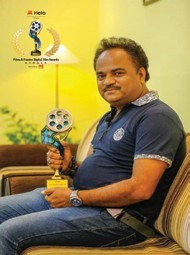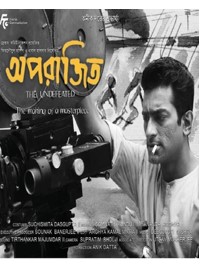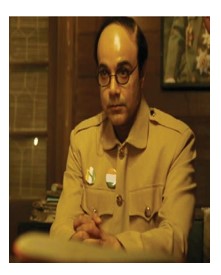“With make-up, you can create a face that doesn’t exist”
 Somnath Kundu
Somnath Kundu
Doing a make-up is a routine regimen for many. Conventionally, it is meant to correct appearance flaws. From an alternative perspective, face can serve as a canvas for work of art — to accentuate one’s natural beauty and create marvels beyond belief. Something that Somnath Kundu does with consummate ease.
Kundu is a prominent name in the Bengali film industry. He has the ability to overhaul the appearance of any actor with deft strokes. He is now trending as the man who miraculously transformed a lesser known TV actor Jeetu Kamal to look like the young Satyajit Ray in Anik Datta’s super box office hit Aparajito.
He talks to Shoma A. Chatterji on his journey as a makeup artist.
When and how did your unusual career as make-up artist in Bengali cinema begin?
I have been in the Bengali film industry for over 25 years. I began young. My grandfather Jyotirindranath Kundu was a much-in-demand costume designer. He died before I was born but he earned lot of respect and appreciation for his work in Bengal. He designed the costumes for classics such as Morutirtha Hinglaj, featuring top stars of the time, apart from being a regular for Tapan Sinha’s and Tarun Majumdar’s films. My father Shyam Kundu picked up when Dadu died, beginning his career with Sagina Mahato. He was good at sculpting models, and I think I inherited this trait. He was hard-working and he is the one who told me to take up make-up as an art form and as a profession instead of becoming a costume designer. All the pot-shots my school mates took at me when they heard my father worked in films were wiped out at one go, when I saw his name in the credits of the film.
What was your first experience of the film industry like?
I dreamt of becoming a teacher. Situation forced me to pay for my higher education by giving tuitions. However, a teaching job meant I do B.Ed. which I could not afford. I took my father’s advice of becoming a make-up man. It was tough as no one wanted to appoint a costume designer’s son as a make-up man. But my father was confident of my talent in drawing/sculpting models and believed I could become a good make-up artist. I worked as an apprentice to the main make-up man for three films for six months without payment. My boss, Subrata Sinha gradually began to have faith in me. I knew the basics of the craft having watched my father work. My superiors noticed my knack for the work. This wasn’t before I had to knock doors before I got work from Subrata Sinha. However, I have no regrets. Today, film directors count on me for challenging assignments. Subrata-da has been a mentor.
The very concept, practice and schism in make-up have changed over the years. How do you explain the evolution?
There have been revolutionary changed in the art and science of make-up in films or in any other media. Earlier, the concept was limited to making women look beautiful. Not so with the males. Today, we concentrate on building up and fleshing out the characters not necessarily to make them look beautiful but to make them look the characters they are playing. This entails challenges. I made Prosenjit Chatterjee look as much like Netaji Subhas Chandra Bose in Srijit Mukherjee’s film Gumnaami. That was tough as he does not look even remotely close to Netaji.
 Actor Jeetu Kamal as the young Satyajit Ray
Actor Jeetu Kamal as the young Satyajit Ray
How has the introduction of prosthetics changed in the world of make-up today?
Prosthetics have come a long way after being tried in the French film A Trip to the Moon in 1902. Look at Amitabh Bachchan in the film Paa. Other classic examples are Planet of the Apes, Frankenstein and Terminator. Prosthetics have revolutionised the entire concept and practice of make-up. You can actually ‘create’ an artificial face with prosthetics. Just like creating artificial limbs for non-existent limbs. You can actually ‘create’ a face that does not exist only through make-up. It is incredible the way an expert make-up artist can make a person look completely different from the way he/she looks without make-up. An ordinary face can be made to look beautiful on screen. This also opens up opportunities for talented artists who are not attractive in the conventional way as the film industry demands. The best example of prosthetics lies in how a young Jeetu Kamal is made to look like a young Satyajit Ray. A film that made a great impact on me was Chachi 420 where Kamal Hasan`s looks were dramatically transformed to make him look like a woman. Earlier, Bengali filmmakers had to hire make-up artists from Mumbai for work. Today, they no longer have to do this.
You became independent in 2000. Which films would you like to mention as your biggest challenges?
For Jamaibabu Zindabad, the fight master Shantanu Pal said he wanted a severed hand in the frame.
 Prosenjit Chatterjee as Subhash Chandra Bose in Gumnaami
Prosenjit Chatterjee as Subhash Chandra Bose in Gumnaami
I did it with whatever materials available and it did look like a severed hand! Technical innovations with more powerful cameras present bigger challenges as even minute mistakes get captured. I enjoyed doing so many changes in Srijit Mukherjee’s horror thriller Vincida which revolves around a very talented make-up man. But Srijit Da objected to one of my changes in make-up as he felt it might scare off the audiences. Add to this changing Jeetu Kamal to a young Satyajjit Ray with the mole on his chin, the pimple scars on his cheeks, his slightly dark skin and even his hair, dating back to the mid-1940s. This has been appreciated by the industry and audience alike. What more could I ask for?


 Shoma A. Chatterji is a freelance journalist, film scholar and author. She has authored 17 published titles and won the National Award for Best Writing on Cinema, twice. She won the UNFPA-Laadli Media Award, 2010 for ‘commitment to addressing and analysing gender issues’ among many awards.
Shoma A. Chatterji is a freelance journalist, film scholar and author. She has authored 17 published titles and won the National Award for Best Writing on Cinema, twice. She won the UNFPA-Laadli Media Award, 2010 for ‘commitment to addressing and analysing gender issues’ among many awards.